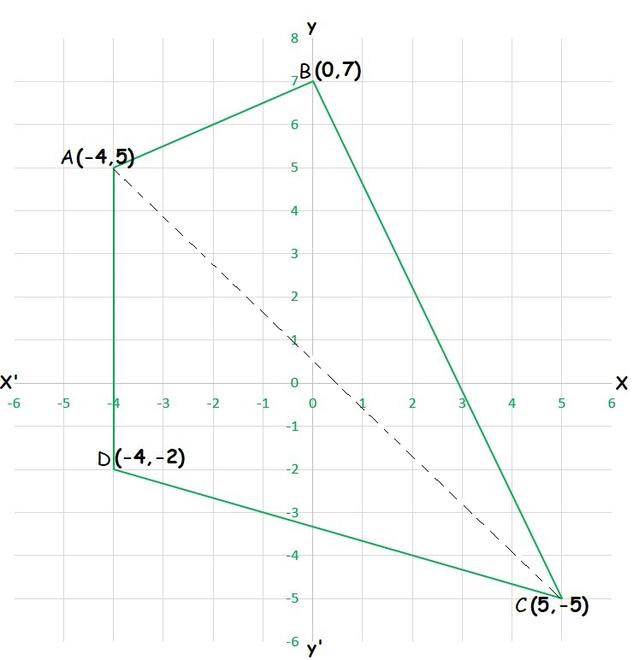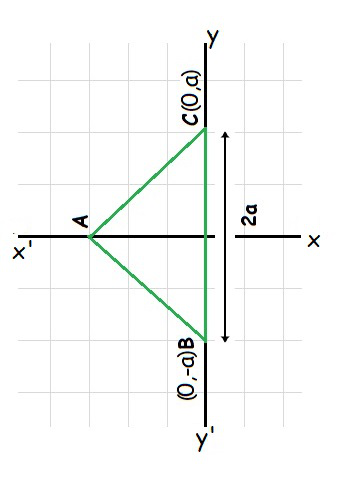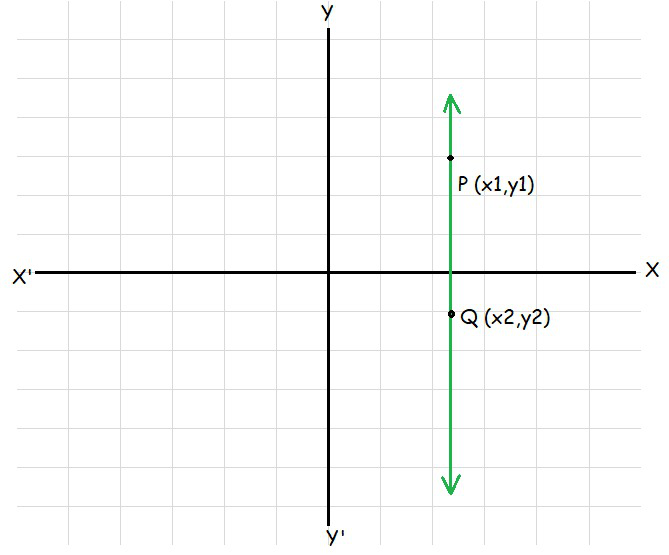问题1.在笛卡尔平面上绘制一个四边形,其顶点为(– 4,5),(0,7),(5,– 5)和(– 4,–2)。另外,找到其区域。
解决方案:
Let’s consider the quadrilateral ABCD with vertices A (-4,5), B (0,7), C (5.-5) and D (-4,-2).
After plotting the points on the Cartesian plane we get the required quadrilateral :
Construction : Join diagonal AC

Area (ABCD) = area (∆ABC) + area (∆ADC)
Then, area of triangle with vertices (x1,y1), (x2, y2) and (x3,y3) is
= |½ [x1 (y2 – y3) + x2 (y3 – y1) + x3 (y1 – y2)]|
So,
Area (∆ABC)= |½ [-4 (7 + 5) + 0 (-5 – 5) + 5 (5 – 7)] |
= |½ [-4 (12) + 5 (-2)] |
= |½ [-48 -10)] |
= | ½ (58) |
= 29 sq. unit
Area (∆ACD) = |½ [-4 (-5 + 2) + 5 (-2 – 5) + (-4) (5 – (-5))]|
= |½ [-4 (-3) + 5 (-7) – 4 (10)]|
= |½ [-12 + -35 – 40]|
= |½ (-63)|
= 63/2 sq. unit
Area (ABCD) = 29 + 63/2
= 121/2 sq. unit
问题2。等边三角形的边为2a的底边沿y轴放置,以使底边的中点位于原点。查找三角形的顶点。
解决方案:
Let’s consider ∆ABC, which is an equilateral triangle with side 2a.
Where, AB = BC = AC = 2a

As in the figure, we assume BC as base, where origin becomes mid-point of BC. So, we can conclude that
The co-ordinates of point C are (0, a) and that of B are (0,-a).
And as origin is the mid-point, so the line joining vertex and origin lies on x-axis. (x-axix ⊥ y-axis)
(AC)2 = OA2 + OC2 (Pythagoras theorem)
(2a)2= a2 + OA2
4a2 – a2 = OA2
OA2 = 3a2
OA =√3a
Co-ordinates of point A = ± (√3a, 0)
∴ The vertices of the given equilateral triangle are (0, a), (0, -a), (√3a, 0) Or (0, a), (0, -a) and (-√3a, 0)
问题3.在以下情况下找到P(x 1 ,y 1 )与Q(x 2 ,y 2 )之间的距离:
(i)PQ平行于y轴,
(ii)PQ平行于x轴。
解决方案:
(i) When PQ is parallel to the y-axis, then the x-coordinates will be same.
so, x1=x2

Distance between points PQ = √((x1-x2)2 + (y1-y2)2)
= √(y1-y2)2 (As x1=x2)
= |y1-y2|
(ii)
When PQ is parallel to the x-axis, then, the y-coordinates will be same.
so, y1=y2

Distance between points PQ = √((x1-x2)2 + (y1-y2)2)
= √(x1-x2)2 (As y1=y2)
= |x1-x2|
问题4.在x轴上找到一个与点(7,6)和(3,4)等距的点。
解决方案:
As it is mentioned that, these points A and B are equidistant from a point P on x-axis.
Let’s take P as (a, 0).

Distance AP = Distance BP
Distance between two points (x1,y1) and (x2,y2)= √((x1-x2)2 + (y1-y2)2)
so,
√((3-a)2 + (4-0)2) = √((7-a)2 + (6-0)2)
√((3-a)2 + 16) = √((7-a)2 + 36)
√(9-6a+a2+16) = √(49-14a+a2+36)
Squaring both sides, we get
a2 – 6a + 25 = a2 – 14a + 85
-8a = -60
a = 15/2
Hence, the point on the x-axis, which is equidistant from the points (7, 6) and (3, 4) is (15/2,0)
问题5.找到一条直线的斜率,该斜率穿过原点,并将线段的中点连接到点P(0,– 4)和点B(8,0)。
解决方案:
Let the co-ordinates of mid-point of the line segment joining the points P (0, – 4) and B (8, 0) be (x,y), so
x = (0+8)/2 = 4
y = (-4+0)/2 = -2
Mid point is (4,-2)
As The slope ‘m’ of the line which is passing through the point (x1,y1) and (x2,y2) will be given as
m = (y2 – y1)/(x2 – x1) where, (x2 ≠ x1)
So now, The slope ‘m’ of the line which is passing through the point (4,-2) and origin (0,0) will be
m = (4-0)/(-2-0) = 4/-2 = -1/2
Hence, the required slope is -1/2.
问题6.不使用毕达哥拉斯定理,请证明点(4,4),(3,5)和(–1,–1)是直角三角形的顶点。
解决方案:
As the vertices of the given triangle are (4, 4), (3, 5) and (–1, –1).

As The slope ‘m’ of the line which is passing through the point (x1,y1) and (x2,y2) will be given as
m = (y2 – y1)/(x2 – x1) where, (x2 ≠ x1)
Let m1 be the slope of the line AB, then
m1 = (4 –(-1))/(4 –(-1)) = 1 ……………….(1)
Let m2 be the slope of the line BC, then
m2 = (3-4)/(5-4) = -1 …………………….(2)
Let m3 be the slope of the line AC, then
m3 = (5-(-1))/(3-(-1)) = 6/4 = 3/2 ………………..(3)
From (1) and (2), we can conclude
m1.m2 = -1.1 = -1
Hence, the lines AB and BC are perpendicular to each other.
Hence, given triangle is right-angled at B (4, 4)
问题7.找到直线的斜率,该斜率与y轴的正方向逆时针方向成30°角。
解决方案:
We know that if a line makes an angle of 30° with the positive direction of y-axis measured anti-clock-wise , then the angle made by the line with the positive direction of x- axis measure anti-clock-wise is
90° + 30° = 120°
∴ The slope of the given line is
tan(120°) = tan (180° – 60°)
= – tan 60°
= –√3
问题8.找到点(x,– 1),(2,1)和(4,5)共线的x的值。
解决方案:
If the points (x, – 1), (2, 1) and (4, 5) are collinear, then
Slope of AB = Slope of BC

Slope of AB = (1-(-1))/(2-x)
= 2/(2-x) ……………….(1)
Slope of BC = (5-1)/(4-2)
= 4/2
= 2 ………………..(2)
from (1) and (2)
2 = 2(2-x)
2 = 4 – 2x
2x = 4 – 2
2x = 2
x = 2/2
= 1
Hence, the required value of x is 1.
问题9.在不使用距离公式的情况下,请显示点(– 2,– 1),(4,0),(3,3)和(–3,2)是平行四边形的顶点。
解决方案:
Let the given point be A (4, 0) , B ( 3, 3) C ( -3, 2) and D (-2, -1) of quadrilateral.

So now, The slope of AD = (0-(-1))/(4-(-2)) = 1/6
The slope of BC = (3-2)/(3-(-3)) = 1/6
Hence, slope of AD = Slope of BC
Hence, AD ∥ BC ……………………..(1)
Now,
The slope of AB = (3-0)/(3-4) = 3/-1 = -3
The slope of CD = (2-(-1))/(-3-(-2)) = 3/-1 = -3
Hence, slope of AB = Slope of CD
Hence, AB ∥ CD ……………………(2)
Hence, from (1) and (2), we can conclude that
The pair of opposite sides are quadrilateral are parallel, so we can say that ABCD is a parallelogram.
Hence the given vertices, A (4, 0), B (3, 3) C (-3, 2) and D (-2, -1) are vertices of a parallelogram.
问题10.找到x轴与连接点(3,–1)和(4,–2)的线之间的角度。
解决方案:
As The slope ‘m’ of the line which is passing through the point (x1,y1) and (x2,y2) will be given as
m = (y2 – y1)/(x2 – x1) where, (x2 ≠ x1)
So now, The slope ‘m’ of the line which is passing through the point (3,–1) and (4,–2) will be
m = (-2 –(-1))/(4-3)
= (-2+1)/(4-3)
= -1/1
= -1
as, m = tan θ
tan θ = -1
θ = (90° + 45°) = 135°
Hence, The angle between the x-axis and the line joining the points (3, –1) and (4, –2) is 135°.
问题11.一条线的斜率是另一条线的斜率的两倍。如果它们之间的角度的切线为1/3,则找到直线的斜率。
解决方案:
Let us consider ‘m1’ and ‘m’ be the slope of the two given lines such that m1 = 2m and,
tan θ = 1/3
We know that if θ is the angle between the lines l1 and l2 with slope m1 and m2, then
tan θ = |(m2-m1) /(1+m1m2)|
so here,
1/3 = |(2m-m) /(1+2m2)|
1/3 = |m/(1+2m2)|
1/3 = ± (m/(1+2m2))
So taking, CASE 1
1/3 = + (m/(1+2m2))
2m2 – 3m + 1 = 0
2m2 – 2m – m + 1 = 0
2m (m – 1) – 1(m – 1) = 0
m = 1 or 1/2 ……………..(1)
And now, solving CASE 2
1/3 = – (m/(1+2m2))
1+2m2 = -3m
2m2 +1 +3m = 0
2m (m+1) + 1(m+1) = 0
(2m+1) (m+1)= 0
m = -1 or -1/2 ………………………(2)
So from (1) and (2) we can conclude that,
The pairs of slopes can be (1 and 2), (-1 and -2), (1 and 1/2) and (-1 and -1/2).
问题12.一条线穿过(x1,y1)和(h,k)。如果直线的斜率是m,则表明
k – y1 = m(h – x1)
解决方案:
As it is given that, the slope of the line is ‘m’
The slope of the line passing through (x1, y1) and (h, k) is (k – y1)/(h – x1)
So,
m = (k – y1)/(h – x1)
(k – y1) = m (h – x1)
Hence, proved.
问题13:如果三个点(h,0),(a,b)和(0,k)在一条线上,则表明a / h + b / k = 1。
解决方案:
If the given points A (h, 0), B (a, b) and C (0, k) lie on a line, then,
Slope of AB = slope of BC
(b – 0)/(a – h) = (k – b)/(0 – a)
By simplifying, we get
-ab = (k-b) (a-h)
-ab = ka- kh –ab +bh
ka +bh = kh
Divide both the sides by kh we get,
ka/kh + bh/kh = kh/kh
a/h + b/k = 1
Hence, proved.
问题14.考虑以下人口和年图(图10.10),找到AB线的斜率并使用它,求出2010年的人口是多少?

解决方案:
As The slope ‘m’ of the line which is passing through the point (x1,y1) and (x2,y2) will be given as
m = (y2 – y1)/(x2 – x1) where, (x2 ≠ x1)
So, the slope ‘m’ of the line which is passing through the point (1985,92) and (1995,97) will be given as
m = (97 – 92)/(1995 – 1985) = 5/10 = 1/2
Let ‘y’ be the population in the year 2010. Then, according to the given graph, AB must pass through point C (2010, y).
slope of AB = slope of BC
1/2 = (y-97)/(2010-1995)
15/2 = y – 97
y = 7.5 + 97 = 104.5
Hence, the slope of the line AB is 1/2, and
In the year 2010 the population will be 104.5 crores.